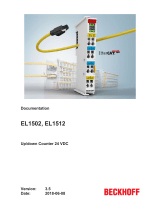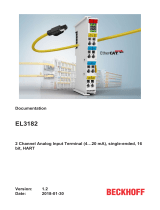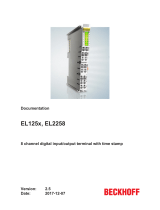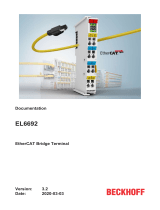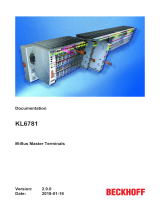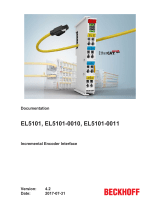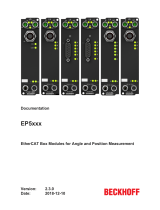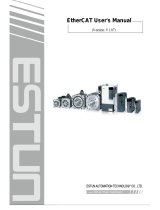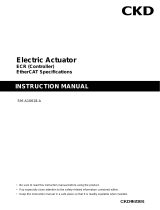Page is loading ...

Documentation
EL922x
Electronic overcurrent protection terminals
1.0
2018-11-23
Version:
Date:


Table of contents
EL922x 3Version: 1.0
Table of contents
1 Product overview electronic overcurrent protection terminal ..............................................................5
2 Foreword ....................................................................................................................................................6
2.1 Notes on the documentation..............................................................................................................6
2.2 Safety instructions .............................................................................................................................7
2.3 Documentation issue status ..............................................................................................................8
2.4 Version identification of EtherCAT devices .......................................................................................9
3 Product overview.....................................................................................................................................13
3.1 Introduction......................................................................................................................................13
3.2 Technical data .................................................................................................................................16
4 Basic function principles........................................................................................................................20
5 Basics communication ...........................................................................................................................21
5.1 EtherCAT basics..............................................................................................................................21
5.2 EtherCAT cabling – wire-bound.......................................................................................................21
5.3 General notes for setting the watchdog...........................................................................................22
5.4 EtherCAT State Machine.................................................................................................................24
5.5 CoE Interface...................................................................................................................................26
6 Mounting and wiring................................................................................................................................31
6.1 Instructions for ESD protection........................................................................................................31
6.2 Installation on mounting rails ...........................................................................................................32
6.3 Connection ......................................................................................................................................35
6.3.1 Connection system .......................................................................................................... 35
6.3.2 Wiring............................................................................................................................... 36
6.4 Prescribed installation position ........................................................................................................38
6.5 Installation instructions for enhanced mechanical load capacity .....................................................39
6.6 Positioning of passive Terminals .....................................................................................................40
6.7 LEDs and pin assignment, programming with LED buttons ............................................................41
6.7.1 EL9221-xxxx .................................................................................................................... 41
6.7.2 EL9222-xxxx .................................................................................................................... 44
6.7.3 EL9227-xxxx .................................................................................................................... 48
6.7.4 Sample programming ...................................................................................................... 52
7 Commissioning........................................................................................................................................54
7.1 Quick start: Commissioning of the EL922x without EtherCAT ........................................................55
7.2 Commissioning and parameterization of the EL922x with EtherCAT..............................................58
7.3 TwinCAT Development Environment ..............................................................................................64
7.3.1 Installation of the TwinCAT real-time driver..................................................................... 64
7.3.2 Notes regarding ESI device description........................................................................... 70
7.3.3 TwinCAT ESI Updater ..................................................................................................... 74
7.3.4 Distinction between Online and Offline............................................................................ 74
7.3.5 OFFLINE configuration creation ...................................................................................... 75
7.3.6 ONLINE configuration creation ........................................................................................ 80
7.3.7 EtherCAT subscriber configuration.................................................................................. 88
7.4 General Notes - EtherCAT Slave Application..................................................................................97
7.5 Process data..................................................................................................................................106

Table of contents
EL922x4 Version: 1.0
7.5.1 EL9221-xxxx .................................................................................................................. 106
7.5.2 EL9222-xxxx .................................................................................................................. 108
7.5.3 EL9227-xxxx .................................................................................................................. 110
7.6 Object description and parameterization .......................................................................................114
7.6.1 EL9221-xxxx .................................................................................................................. 115
7.6.2 EL9222-xxxx .................................................................................................................. 123
7.6.3 EL9227-xxxx .................................................................................................................. 131
8 Diagnostics ............................................................................................................................................148
8.1 Diagnostics – basic principles of diag messages ..........................................................................148
8.2 Text ID’s EL922x ...........................................................................................................................151
9 Appendix ................................................................................................................................................152
9.1 EtherCAT AL Status Codes...........................................................................................................152
9.2 Firmware compatibility...................................................................................................................152
9.3 Firmware Update EL/ES/EM/EPxxxx ............................................................................................154
9.3.1 Device description ESI file/XML..................................................................................... 155
9.3.2 Firmware explanation .................................................................................................... 158
9.3.3 Updating controller firmware *.efw................................................................................. 159
9.3.4 FPGA firmware *.rbf....................................................................................................... 160
9.3.5 Simultaneous updating of several EtherCAT devices.................................................... 164
9.4 Restoring the delivery state ...........................................................................................................165
9.5 Support and Service ......................................................................................................................167

Product overview electronic overcurrent protection terminal
EL922x 5Version: 1.0
1 Product overview electronic overcurrent
protection terminal
EL9221-4030 Overcurrent protection terminal [}13], 1-channel, I
N
3 A,
EL9221-5000 Overcurrent protection terminal [}13], 1-channel, I
N
adjustable up to 10 A,
EL9221-5090 Overcurrent protection terminal [}13], 1-channel, I
N
10 A,
EL9221-6000 Overcurrent protection terminal [}13], 1-channel, I
N
adjustable up to 4 A,
EL9221-6040 Overcurrent protection terminal [}13], 1-channel, I
N
4 A,
EL9221-9060 Overcurrent protection terminal [}13], 1-channel, I
N
6 A,
EL9221-9080 Overcurrent protection terminal [}13], 1-channel, I
N
8 A,
EL9222-4433 Overcurrent protection terminal [}14], 2-channel, I
N
3 A/ 3 A,
EL9222-5500 Overcurrent protection terminal [}14], 2-channel, I
N
adjustable up to ∑10 A,
EL9222-6600 Overcurrent protection terminal [}14], 2-channel, I
N
adjustable up to 4 A,
EL9222-6644 Overcurrent protection terminal [}14], 2-channel, I
N
4 A/ 4 A,
EL9222-9482 Overcurrent protection terminal [}14], 2-channel, I
N
8 A/ 2 A,
EL9222-9664 Overcurrent protection terminal [}14], 2-channel, I
N
6 A/ 4 A,
EL9227-4433 Overcurrent protection terminal [}14], 2-channel, I
N
3 A/ 3 A, extended functionalities
EL9227-5500 Overcurrent protection terminal [}14], 2-channel, I
N
adjustable up to ∑10 A, extended
functionalities
EL9227-6600 Overcurrent protection terminal [}14], 2-channel, I
N
adjustable up to 4 A, extended
functionalities
EL9227-6644 Overcurrent protection terminal [}14], 2-channel, I
N
4 A/ 4 A, extended functionalities
EL9227-9482 Overcurrent protection terminal [}14], 2-channel, I
N
8 A/ 2 A, extended functionalities
EL9227-9664 Overcurrent protection terminal [}14], 2-channel, I
N
6 A/ 4 A, extended functionalities
Specification of the type designation for Overcurrent Protection Terminals
Fig.1: Key type designation

Foreword
EL922x6 Version: 1.0
2 Foreword
2.1 Notes on the documentation
Intended audience
This description is only intended for the use of trained specialists in control and automation engineering who
are familiar with the applicable national standards.
It is essential that the documentation and the following notes and explanations are followed when installing
and commissioning these components.
It is the duty of the technical personnel to use the documentation published at the respective time of each
installation and commissioning.
The responsible staff must ensure that the application or use of the products described satisfy all the
requirements for safety, including all the relevant laws, regulations, guidelines and standards.
Disclaimer
The documentation has been prepared with care. The products described are, however, constantly under
development.
We reserve the right to revise and change the documentation at any time and without prior announcement.
No claims for the modification of products that have already been supplied may be made on the basis of the
data, diagrams and descriptions in this documentation.
Trademarks
Beckhoff
®
, TwinCAT
®
, EtherCAT
®
, EtherCATP
®
, SafetyoverEtherCAT
®
, TwinSAFE
®
, XFC
®
and XTS
®
are
registered trademarks of and licensed by Beckhoff Automation GmbH.
Other designations used in this publication may be trademarks whose use by third parties for their own
purposes could violate the rights of the owners.
Patent Pending
The EtherCAT Technology is covered, including but not limited to the following patent applications and
patents: EP1590927, EP1789857, DE102004044764, DE102007017835 with corresponding applications or
registrations in various other countries.
The TwinCAT Technology is covered, including but not limited to the following patent applications and
patents: EP0851348, US6167425 with corresponding applications or registrations in various other countries.
EtherCAT
®
is registered trademark and patented technology, licensed by Beckhoff Automation GmbH,
Germany.
Copyright
© Beckhoff Automation GmbH & Co. KG, Germany.
The reproduction, distribution and utilization of this document as well as the communication of its contents to
others without express authorization are prohibited.
Offenders will be held liable for the payment of damages. All rights reserved in the event of the grant of a
patent, utility model or design.

Foreword
EL922x 7Version: 1.0
2.2 Safety instructions
Safety regulations
Please note the following safety instructions and explanations!
Product-specific safety instructions can be found on following pages or in the areas mounting, wiring,
commissioning etc.
Exclusion of liability
All the components are supplied in particular hardware and software configurations appropriate for the
application. Modifications to hardware or software configurations other than those described in the
documentation are not permitted, and nullify the liability of Beckhoff Automation GmbH & Co. KG.
Personnel qualification
This description is only intended for trained specialists in control, automation and drive engineering who are
familiar with the applicable national standards.
Description of instructions
In this documentation the following instructions are used.
These instructions must be read carefully and followed without fail!
DANGER
Serious risk of injury!
Failure to follow this safety instruction directly endangers the life and health of persons.
WARNING
Risk of injury!
Failure to follow this safety instruction endangers the life and health of persons.
CAUTION
Personal injuries!
Failure to follow this safety instruction can lead to injuries to persons.
NOTE
Damage to environment/equipment or data loss
Failure to follow this instruction can lead to environmental damage, equipment damage or data loss.
Tip or pointer
This symbol indicates information that contributes to better understanding.

Foreword
EL922x8 Version: 1.0
2.3 Documentation issue status
Version Comment
1.0 - 1
st
public issue
- Complements, corrections
0.2 – 0.9.3 - Complements, corrections
0.1 - Provisional documentation for EL922x

Foreword
EL922x 9Version: 1.0
2.4 Version identification of EtherCAT devices
Designation
A Beckhoff EtherCAT device has a 14-digit designation, made up of
• family key
• type
• version
• revision
Example Family Type Version Revision
EL3314-0000-0016 EL terminal
(12 mm, non-
pluggable connection
level)
3314 (4-channel thermocouple
terminal)
0000 (basic type) 0016
ES3602-0010-0017 ES terminal
(12 mm, pluggable
connection level)
3602 (2-channel voltage
measurement)
0010 (high-
precision version)
0017
CU2008-0000-0000 CU device 2008 (8-port fast ethernet switch) 0000 (basic type) 0000
Notes
• The elements mentioned above result in the technical designation. EL3314-0000-0016 is used in the
example below.
• EL3314-0000 is the order identifier, in the case of “-0000” usually abbreviated to EL3314. “-0016” is the
EtherCAT revision.
• The order identifier is made up of
- family key (EL, EP, CU, ES, KL, CX, etc.)
- type (3314)
- version (-0000)
• The revision -0016 shows the technical progress, such as the extension of features with regard to the
EtherCAT communication, and is managed by Beckhoff.
In principle, a device with a higher revision can replace a device with a lower revision, unless specified
otherwise, e.g. in the documentation.
Associated and synonymous with each revision there is usually a description (ESI, EtherCAT Slave
Information) in the form of an XML file, which is available for download from the Beckhoff web site.
From 2014/01 the revision is shown on the outside of the IP20 terminals, see Fig. “EL5021 EL terminal,
standard IP20 IO device with batch number and revision ID (since 2014/01)”.
• The type, version and revision are read as decimal numbers, even if they are technically saved in
hexadecimal.
Identification number
Beckhoff EtherCAT devices from the different lines have different kinds of identification numbers:
Production lot/batch number/serial number/date code/D number
The serial number for Beckhoff IO devices is usually the 8-digit number printed on the device or on a sticker.
The serial number indicates the configuration in delivery state and therefore refers to a whole production
batch, without distinguishing the individual modules of a batch.
Structure of the serial number: KKYYFFHH
KK - week of production (CW, calendar week)
YY - year of production
FF - firmware version
HH - hardware version

Foreword
EL922x10 Version: 1.0
Example with
Ser. no.: 12063A02: 12 - production week 12 06 - production year 2006 3A - firmware version 3A 02 -
hardware version 02
Exceptions can occur in the IP67 area, where the following syntax can be used (see respective device
documentation):
Syntax: D ww yy x y z u
D - prefix designation
ww - calendar week
yy - year
x - firmware version of the bus PCB
y - hardware version of the bus PCB
z - firmware version of the I/O PCB
u - hardware version of the I/O PCB
Example: D.22081501 calendar week 22 of the year 2008 firmware version of bus PCB: 1 hardware version
of bus PCB: 5 firmware version of I/O PCB: 0 (no firmware necessary for this PCB) hardware version of I/O
PCB: 1
Unique serial number/ID, ID number
In addition, in some series each individual module has its own unique serial number.
See also the further documentation in the area
• IP67: EtherCAT Box
• Safety: TwinSafe
• Terminals with factory calibration certificate and other measuring terminals
Examples of markings
Fig.2: EL5021 EL terminal, standard IP20 IO device with serial/ batch number and revision ID (since
2014/01)

Foreword
EL922x 11Version: 1.0
Fig.3: EK1100 EtherCAT coupler, standard IP20 IO device with serial/ batch number
Fig.4: CU2016 switch with serial/ batch number
Fig.5: EL3202-0020 with serial/ batch number 26131006 and unique ID-number 204418

Foreword
EL922x12 Version: 1.0
Fig.6: EP1258-00001 IP67 EtherCAT Box with batch number/ date code 22090101 and unique serial
number 158102
Fig.7: EP1908-0002 IP67 EtherCAT Safety Box with batch number/ date code 071201FF and unique serial
number 00346070
Fig.8: EL2904 IP20 safety terminal with batch number/ date code 50110302 and unique serial number
00331701
Fig.9: ELM3604-0002 terminal with unique ID number (QR code) 100001051 and serial/ batch number
44160201

Product overview
EL922x 13Version: 1.0
3 Product overview
3.1 Introduction
Electronic overcurrent protection terminal
EL9221-xxxx | Single-channel overcurrent protection terminal with standard functionalities
Fig.10: EL9221-5000
The EL9221-xxxx electronic overcurrent protection terminal is a 24 V DC EtherCAT Terminal with electronic
protection function. The single-channel EL9221-xxxx reliably switches off 24 V DC overcurrents. The nominal
current can be set in 1 A steps up to 10 A, either via TwinCAT or via a mechanical pushbutton on the
overcurrent protection terminal. In addition, there are further versions of the terminal with a fixed nominal
current. The protected output can be routed out via a terminal contact or directly to adjacent terminals
without wiring via the power contact.
The EL9221-xxxx has standard functionalities, i.e. the following setting options and process data are
available:
- Settings: Nominal current, LED button programming function
- Process data: Enabled, tripped, prewarning, cool-down lock, hardware protection

Product overview
EL922x14 Version: 1.0
EL9222-xxxx | Two-channel overcurrent protection terminal with standard functionalities
Fig.11: EL9222-5500
The EL9222-xxxx electronic overcurrent protection terminal is a 24 V DC EtherCAT Terminal with electronic
protection function. The 2-channel EL9222-xxxx reliably switches off 24 V DC overcurrents. The nominal
current can be set in 1 A steps up to ∑ 10 A, either via TwinCAT or via a mechanical pushbutton on the
overcurrent protection terminal. In addition, there are further versions of the terminal with a fixed nominal
current for each channel. The protected output 1 can be routed out via a terminal contact or directly to
adjacent terminals without wiring via the power contact.
The EL9222-xxxx has standard functionalities, i.e. the following setting options and process data are
available:
- Settings: Nominal current, LED button programming function
- Process data: Enabled, tripped, prewarning, cool-down lock, hardware protection
EL9227-xxxx | Two-channel overcurrent protection terminal with extended functionalities
Fig.12: EL9227-5500
The EL9227-xxxx electronic overcurrent protection terminal is a 24 V DC EtherCAT Terminal with electronic
protection function. The 2-channel EL9227-xxxx reliably switches off 24 V DC overcurrents. The nominal
current can be set in 1 A steps up to ∑ 10 A, either via TwinCAT or via a mechanical pushbutton on the
overcurrent protection terminal. In addition, there are further versions of the terminal with a fixed nominal
current for each channel. The protected output 1 can be routed out via a terminal contact or directly to
adjacent terminals without wiring via the power contact.

Product overview
EL922x 15Version: 1.0
The EL9227-xxxx has extended functionalities, i.e. it is additionally able to handle monitoring applications,
since numerous process data are available, e.g.:
enabled, tripped, short circuit, overload, overvoltage, undervoltage, current level warning, cool down lock,
hardware protection, switched off by pushbutton, DI, EtherCAT, load, instantaneous current, input voltage
and output voltage.
Furthermore, it can be used flexibly, since numerous settings are available individually, e.g.:
nominal current, characteristics, manual characteristics, prewarning, start behavior, input behavior,
overvoltage behavior, undervoltage level, reverse feed behavior, LED button programming function.
All EL9227 terminals are equipped with protection against reverse polarity and reverse feed
Quick links
Also see about this
2 Technical data [}16]
2 Mounting and wiring [}31]
2 Object description and parameterization [}114]

Product overview
EL922x16 Version: 1.0
3.2 Technical data
Technical data EL9221-5000 EL9221-6000 EL9221-4030 EL9221-6040 EL9221-9060 EL9221-9080 EL9221-5090
Nominal voltage 24V
DC
(-15 %/+20 %)
Nominal current max. 10 A,
adjustable
max. 4 A, ad-
justable
3 A, fixed 4 A, fixed 6 A, fixed 8 A, fixed 10 A, fixed
Nominal current steps 1, 2, 3, 4, 5,
6, 7, 8, 9, 10
A
1, 2, 3, 4 A
Input current max. 10A (Input current = forwarding current + current of the own terminal)
Number of outputs 1
Output 1 Terminal contact and power contact
Power contacts (right) +24 V DC protected; 0V DC
Number of digital inputs 1 (24V DC falling edge -15% + 20%); same 0 V reference as input voltage
Prewarning output load Fixed 90%, 5% hysteresis
Tripping behavior
see tables showing tripping times [}19]
Restart time ≥ 10 seconds*
Internal fuse (faile-safe ele-
ment)
15 A (F) 6 A (T) 4 A (T) 6 A (T) 10 A (F) 10 A (F) 15 A (F)
Internal max. power dissipa-
tion limitation
typically 400
W for 20 ms
typically 160
W for 50 ms
typically 160
W for 50 ms
typically 160
W for 50 ms
typically 266
W for 30 ms
typically 266
W for 30 ms
typically 400
W for 20 ms
Max. current limitation typically 25 A
for 20 ms
typically 10 A
for 50 ms
typically 10 A
for 50 ms
typically 10 A
for 50 ms
typically 16 A
for 30 ms
typically 16 A
for 30 ms
typically 25 A
for 20 ms
Switch-on delay typical 15ms
Overcurrent protection op-
eration without E-bus
Yes
Switch-on capacitance typically 20,000 µF**
Overvoltage shutdown > 32 V DC
Parallel connection of sev-
eral outputs
not permissible
E-Bus current consumption typ. 80mA
Electrical connection to
mounting rail
Yes
Measuring error typ. ± 100 mA @23°C+- 20°C @24 V
Electrical isolation 500 V (E-bus/signal voltage)
Dimensions (WxHxD) approx. 15mm x 100mm x 70mm (width aligned: 12mm)
Weight approx. 60g
Permissible ambient tem-
perature range during oper-
ation
0°C ... + 55°C
Permissible ambient tem-
perature range during stor-
age
-25°C ... + 85°C
Permissible relative air hu-
midity
95%, no condensation
Mounting [}32]
on 35mm mounting rail according to EN 60715
Vibration / shock resistance conforms to EN60068-2-6 / EN60068-2-27
EMC immunity/emission conforms to EN61000-6-2 / EN61000-6-4
Installation position
see note [}38]!
Protection class IP20
Approvals CE
*) for further explanations see note in chapter Commissioning [}54]
**) depending on: installed power supply, line resistance, load current, component tolerances, selected current range

Product overview
EL922x 17Version: 1.0
Technical data EL9222-5500 EL9222-6600 EL9222-4433 EL9222-6644 EL9222-9664 EL9222-9482
Nominal voltage 24V
DC
(-15 %/+20 %)
Nominal current Max. Ʃ10 A
ajustable
max. 4 A, ad-
justable
3 A / 3 A,
fixed
4 A / 4 A,
fixed
6 A / 4 A,
fixed
8 A / 2 A,
fixed
Nominal current steps 1, 2, 3, 4, 5, 6,
7, 8, 9, 10 A
1, 2, 3, 4 A
Input current max. 10A (Input current = forwarding current + current of the own terminal)
Number of outputs 2
Output 1 Terminal contact and power contact
Power contacts (right) +24 V DC protected; 0V DC
Number of digital inputs 2 (24V DC falling edge -15% + 20%); same 0 V reference as input voltage
Prewarning output load Fixed 90%, 5% hysteresis
Tripping behavior
see tables showing tripping times [}19]
Restart time ≥ 10 seconds*
Internal fuse (faile-safe ele-
ment)
(channel1/channel2)
15 A (F) /
15 A (F)
6 A (T) /
6 A (T)
4 A (T) /
4 A (T)
6 A (T) /
6 A (T)
10 A (F) /
6 A (T)
10 A (F) /
4 A (T)
Internal max. power dissi-
pation limitation (channel1/
channel2)
typically 400 W
for 20 ms /
typically 400 W
for 20 ms
typically 160 W
for 50 ms / typi-
cally 160 W for
50 ms
typically 160 W
for 50 ms / typi-
cally 160 W for
50 ms
typically 160 W
for 50 ms / typi-
cally 160 W for
50 ms
typically 266 W
for 30 ms /
typically 160 W
for 50 ms
typically 266 W
for 30 ms /
typically 160 W
for 50 ms
Max. current limitation
(channel1/channel2)
typically 25 A for
20 ms /
typically 25 A for
20 ms
typically 10 A for
50 ms /
typically 10 A for
50 ms
typically 10 A for
50 ms /
typically 10 A for
50 ms
typically 10 A for
50 ms /
typically 10 A for
50 ms
typically 16 A for
30 ms /
typically 10 A for
50 ms
typically 16 A for
30 ms /
typically 10 A for
50 ms
Switch-on delay typical 15ms
Overcurrent protection op-
eration without E-bus
Yes
Switch-on capacitance typically 20,000 µF**
Overvoltage shutdown > 32 V DC
Parallel connection of sev-
eral outputs
not permissible
E-Bus current consumption typ. 80mA
Electrical connection to
mounting rail
Yes
Measuring error typ. ± 100 mA @23°C+- 20°C @24 V
Electrical isolation 500 V (E-bus/signal voltage)
Dimensions (WxHxD) approx. 15mm x 100mm x 70mm (width aligned: 12mm)
Weight approx. 60g
Permissible ambient tem-
perature range during oper-
ation
0°C ... + 55°C
Permissible ambient tem-
perature range during stor-
age
-25°C ... + 85°C
Permissible relative air hu-
midity
95%, no condensation
Mounting [}32]
on 35mm mounting rail according to EN60715
Vibration / shock resistance conforms to EN60068-2-6 / EN60068-2-27
EMC immunity/emission conforms to EN61000-6-2 / EN61000-6-4
Installation position
see note [}38]!
Protection class IP20
Approvals CE
*) for further explanations see note in chapter Commissioning [}54]
**) depending on: installed power supply, line resistance, load current, component tolerances, selected current range

Product overview
EL922x18 Version: 1.0
Technical data EL9227-5500 EL9227-6600 EL9227-4433 EL9227-6644 EL9227-9664 EL9227-9482
Nominal voltage 24V
DC
(-15 %/+20 %)
Nominal current Max. Ʃ10 A, ad-
justable
Max. 4 A, ad-
justable
3 A / 3 A, fixed 4 A / 4 A, fixed 6 A / 4 A, fixed 8 A / 2 A, fixed
Nominal current steps 1, 2, 3, 4, 5, 6, 7,
8, 9, 10 A
1, 2, 3, 4 A
Input current max. 10A (Input current = forwarding current + current of the own terminal)
Number of outputs 2
Output 1 Terminal contact and power contact
Power contacts (right) +24V DC protected; 0V DC
Number of digital inputs 2 (24V DC falling edge -15% + 20%); same 0 V reference as input voltage
Prewarning output load Adjustable between 50% and 100%, 5% hysteresis
Tripping behavior
see tables showing tripping times [}19]
Restart time ≥ 10 seconds (temperature-dependent)*
Internal fuse (faile-safe ele-
ment) (channel1/channel2)
15 A (F) / 15 A
(F)
6 A (T) / 6 A (T) 4 A (T) / 4 A (T) 6 A (T) / 6 A (T) 10 A (F) / 6 A (T) 10 A (F) / 4 A (T)
Internal max. power dissi-
pation limitation (channel1/
channel2)
typically 400 W
for 20 ms /
typically 400 W
for 20 ms
typically 160 W
for 50 ms / typi-
cally 160 W for
50 ms
typically 160 W
for 50 ms / typi-
cally 160 W for
50 ms
typically 160 W
for 50 ms / typi-
cally 160 W for
50 ms
typically 266 W
for 30 ms /
typically 160 W
for 50 ms
typically 266 W
for 30 ms /
typically 160 W
for 50 ms
Max. current limitation
(channel1/channel2)
typically 25 A for
20 ms / typically
25 A for 20 ms
typically 10 A for
50 ms / typically
10 A for 50 ms
typically 10 A for
50 ms / typically
10 A for 50 ms
typically 10 A for
50 ms / typically
10 A for 50 ms
typically 16 A for
30 ms / typically
10 A for 50 ms
typically 16 A for
30 ms / typically
10 A for 50 ms
Switch-on delay typical 15ms
Overcurrent protection op-
eration without E-bus
Yes
Switch-on capacitance typically 20,000 µF**
Undervoltage prewarning Adjustable between 17 and 24 V DC
Overvoltage shutdown > 32 V DC
Reverse polarity switch-off Yes
Reverse feed shutdown U
Out
+ 1 V > U
In
Switch-off times adjustable in 3 steps (fast: after 10 ms, standard: after 100 ms, slow: after 1000 ms)
Parallel connection of sev-
eral outputs
not permissible
E-Bus current consumption typ. 80mA
Electrical connection to
mounting rail
Yes
Measuring error typ. ± 75 mA @23°C+- 20°C @24 V
typ. ± 150 mV @23°C+- 20°C @24 V
Electrical isolation 500 V (E-bus/signal voltage)
Dimensions (WxHxD) approx. 15mm x 100mm x 70mm (width aligned: 12mm)
Weight approx. 60g
Permissible ambient tem-
perature range during oper-
ation
0°C ... + 55°C
Permissible ambient tem-
perature range during stor-
age
-25°C ... + 85°C
Permissible relative air hu-
midity
95%, no condensation
Mounting [}32]
on 35mm mounting rail according to EN60715
Vibration / shock resistance conforms to EN60068-2-6 / EN60068-2-27
EMC immunity/emission conforms to EN61000-6-2 / EN61000-6-4
Installation position
see note [}38]!
Protection class IP20
Approvals CE
*) for further explanations see note in chapter Commissioning [}54]
**) depending on: installed power supply, line resistance, load current, component tolerances, selected current range

Product overview
EL922x 19Version: 1.0
Table1: Typical tripping times for: EL9221-5000*; EL9221-5090*; EL9222-5500*; EL9227-5500
X * I
N
Current fast standard slow
t / in ms
1.1 7,000 10,000 15,000
1.2 7,000 10,000 15,000
1.3 3,500 5,000 7,500
1.4 3,500 5,000 7,500
1.5 700 1,000 1,500
1.6 700 1,000 1,500
1.7 700 1,000 1,500
1.8 70 100 150
1.9 70 100 150
≥ 2 Max. typ. 25A 1 8 12
*) only “standard” for these variants
Table2: Typical tripping times for: EL9221-9060*; EL9221-9080*; EL9222-9664 (channel 1)*; EL9222-9482
(channel 1)*; EL9227-9664 (channel 1), EL9227-9482 (channel 1)
X * I
N
Current fast standard slow
t / in ms
1.1 7,000 10,000 15,000
1.2 7,000 10,000 15,000
1.3 3,500 5,000 7,500
1.4 3,500 5,000 7,500
1.5 700 1,000 1,500
1.6 700 1,000 1,500
1.7 700 1,000 1,500
1.8 70 100 150
1.9 70 100 150
≥ 2 Max. typ. 16A 1 8 12
*) only “standard” for these variants
Table3: Typical tripping times for: EL9221-4030*; EL9221-6000*; EL9221-6040*; EL9222-4433*;
EL9222-6600*; EL9222-6644*; EL9227-4433; EL9227-6600; EL9227-6644; EL9222-9664 (channel 2)*;
EL9227-9664 (channel 2); EL9227-9482 (channel 2); EL9222-9482 (channel 2)*
X * I
N
Current fast standard slow
t / in ms
1.1 7,000 10,000 15,000
1.2 7,000 10,000 15,000
1.3 3,500 5,000 7,500
1.4 3,500 5,000 7,500
1.5 700 1,000 1,500
1.6 700 1,000 1,500
1.7 700 1,000 1,500
1.8 70 100 150
1.9 70 100 150
≥ 2 Max. typ. 10A 1 8 12
*) only “standard” for these variants

Basic function principles
EL922x20 Version: 1.0
4 Basic function principles
The functional principle of the electronic overcurrent protection terminals is based on measurement and
evaluation of the current flow. Depending on the result of the evaluation, the corresponding action is then
executed. One possible action is shutdown.
There are several shutdown options: once according to typical tripping times (characteristic curve), according
to hardware parameters or after exceeding the limit load integral..
Shutdown based on characteristic curve
Shutdown based on the characteristic curve can take place if the outputs were previously switched on
successfully. How long the respective overcurrent may flow until the shutdown is triggered depends on the
tripping times specified in the characteristic curve. Typical tripping times can be found under Technical data
[}19].
Shutdown based on hardware parameters
The electronic overcurrent protection terminals EL9221, EL9222 and EL9227 have an internal current and
power limitation based on hardware parameters. The shut-down according to hardware parameters (power
limitation / current limitation) occurs when the outputs are already overloaded when switched on and could
not be switched on. If, for example, an existing short-circuit is switched on. However, the hardware shut-
down also takes effect in characteristic curve operation if the power limit and/or current limit are exceeded. If
one of them is exceeded, the switch-off takes place after a fixed time.
The specification of the power dissipation limitation refers to the internal power dissipation in the terminal.
The value of the power dissipation limitation is fixed, whereas the current flow depends on the voltage drop
in the terminal. For example, if a 0 Ohm short circuit was present, the 24 V DC would drop completely in the
terminal. A power limitation of 400 W would result in a current of approx. 16.67 A until shutdown. Depending
on the voltage distribution, the current increases, but only to a maximum limiting value. The respective
limitation values can be found under Technical data [}16].
The power loss limitation including current limitation is always active. This means that this function is always
available regardless of whether the outputs could already be switched on or not.
Shutdown after exceeding the limit load integral
The tripping time can vary if, for example, the limit load integral is exceeded.
Example: In pulsed operation, an overcurrent occurs several times in succession. Shortly before the switch-
off, the overcurrent remains off, and then returns after a short time. As a result, the limit load integral has
built up and finally a switch-off occurs.
Shutdown during the switch-on process
Electrical loads can be switched on in two different ways. Once directly via the output at the overcurrent
protection terminal or via other switching products. When the load is switched on via the channel at the
terminal, the power dissipation and current limitation values are decisive for a possible switch-off at the
switch-on time. When a load is switched on via additional switching terminals (output of the overcurrent
protection terminal is already switched on), the data of the characteristic curve are decisive.
/
